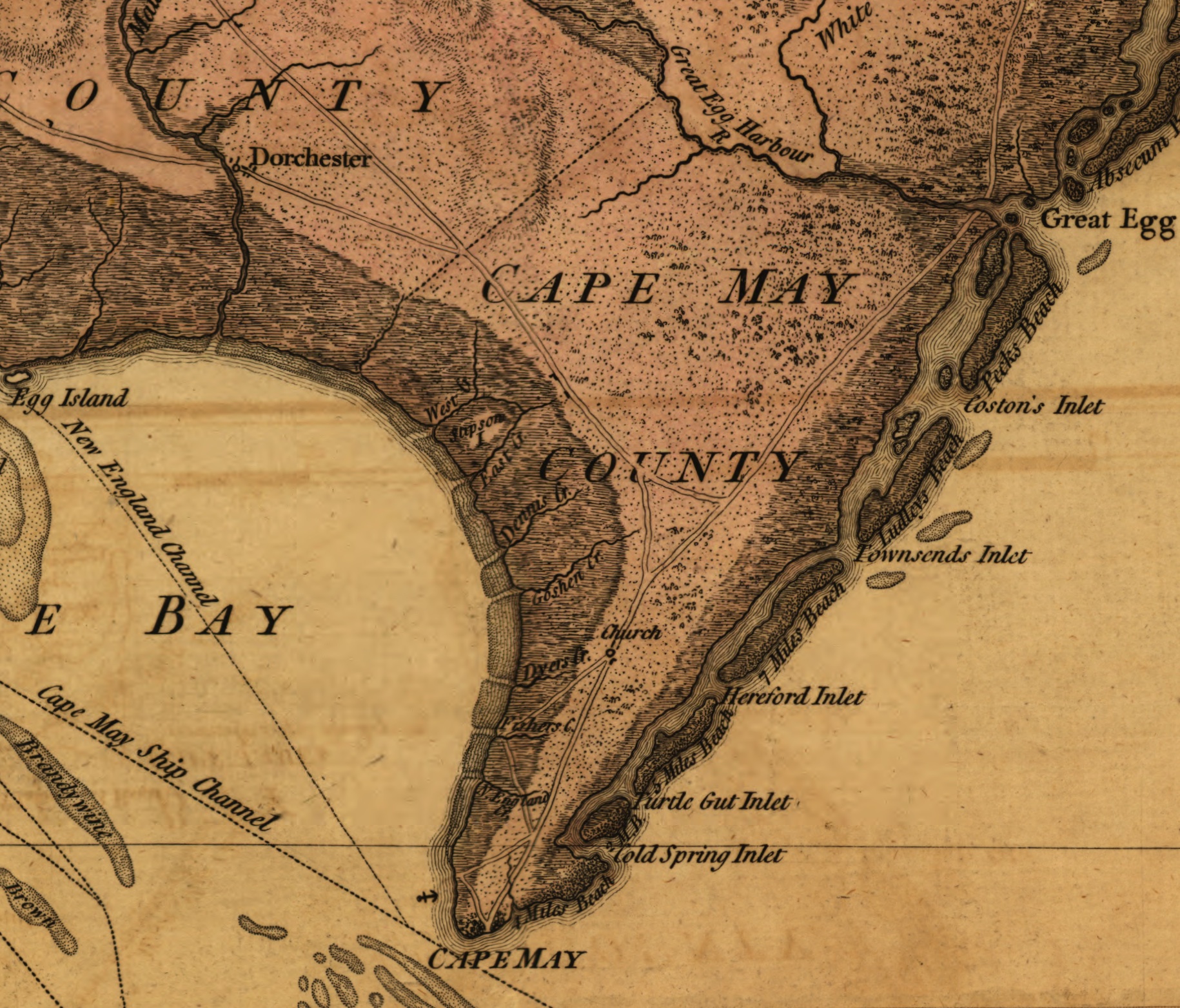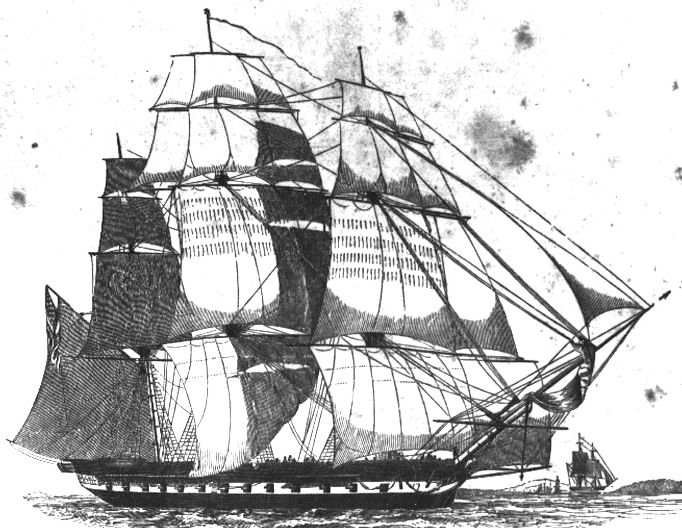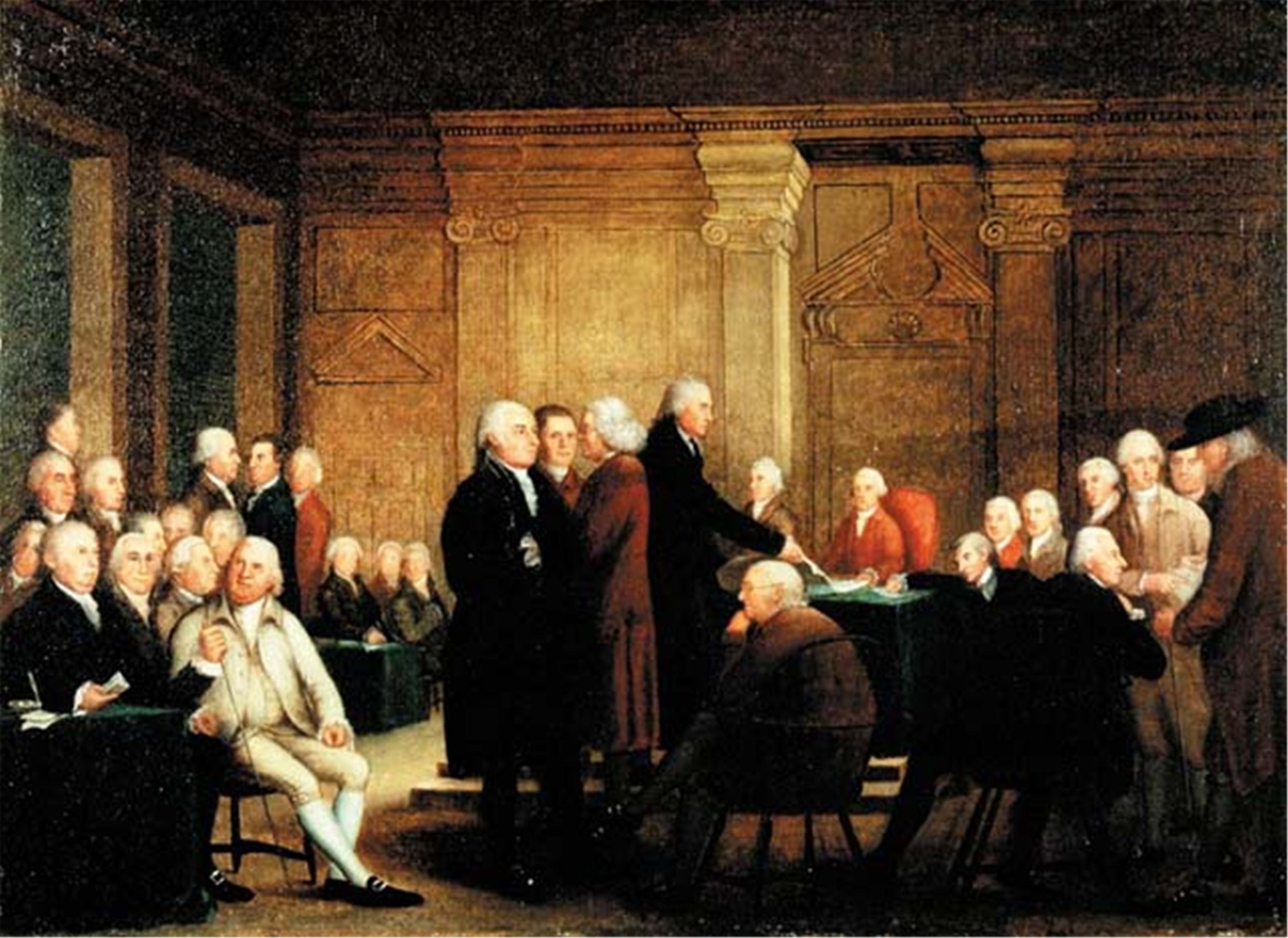|
Commodore John Barry
John Barry (March 25, 1745 – September 13, 1803) was an Irish-American officer in the Continental Navy during the American Revolutionary War and later in the United States Navy. He has been credited as "The Father of the American Navy" (and shares that moniker with John Paul Jones and John Adams) and was appointed a captain in the Continental Navy on December 7, 1775. He was the first captain placed in command of a U.S. warship commissioned for service under the Continental flag. After the war, he became the first commissioned U.S. naval officer, at the rank of commodore, receiving his commission from President George Washington in 1797. Early life and education Barry was born on March 25, 1745, in Ballysampson, Tacumshane, County Wexford, Ireland to a Catholic family. When Barry's family was evicted from their home by their English landlord, they moved to Rosslare on the coast, where his uncle worked a fishing skiff. As a young man, Barry determined upon a life as a sea ... [...More Info...] [...Related Items...] OR: [Wikipedia] [Google] [Baidu] |
Gilbert Stuart
Gilbert Charles Stuart ( Stewart; December 3, 1755 – July 9, 1828) was an American painter from Rhode Island Colony who is widely considered one of America's foremost portraitists. His best-known work is an unfinished portrait of George Washington, begun in 1796, which is sometimes referred to as the ''Athenaeum Portrait''. Stuart retained the portrait and used it to paint scores of copies that were commissioned by patrons in America and abroad. The image of George Washington featured in the painting has appeared on the United States one-dollar bill for more than a centuryGilbert Stuart Birthplace and Museum . ''Gilbert Stuart Biography''. Accessed July 24, 2007. and on various |
George Washington
George Washington (February 22, 1732, 1799) was an American military officer, statesman, and Founding Father who served as the first president of the United States from 1789 to 1797. Appointed by the Continental Congress as commander of the Continental Army, Washington led the Patriot forces to victory in the American Revolutionary War and served as the president of the Constitutional Convention of 1787, which created the Constitution of the United States and the American federal government. Washington has been called the " Father of his Country" for his manifold leadership in the formative days of the country. Washington's first public office was serving as the official surveyor of Culpeper County, Virginia, from 1749 to 1750. Subsequently, he received his first military training (as well as a command with the Virginia Regiment) during the French and Indian War. He was later elected to the Virginia House of Burgesses and was named a delegate to the Continental Congress ... [...More Info...] [...Related Items...] OR: [Wikipedia] [Google] [Baidu] |
Nancy (1775)
''Nancy'' was an American sailing vessel, noted in sources as either a brig or a brigantine, that was chartered to transport war supplies during the American Revolutionary War. After learning that independence had been declared, her captain, according to his daughter, raised the first American flag in a foreign port. Evading British capture, she was later intentionally destroyed with a huge blast on June 29, 1776, during the Battle of Turtle Gut Inlet near Cape May, New Jersey. History Construction ''Nancy'' was built by Barney Harris in Wilmington, Delaware, and was owned by Joseph Shallcross, Joseph Tatnall, and others. Her captain was Hugh Montgomery, also from Wilmington. Another part owner was Vincent Gilpin, who named the brig after his daughter Ann. Nancy is a diminutive form of Ann Military charter On March 1, 1776, Robert Morris of the Pennsylvania Committee of Safety chartered ''Nancy'' to transport gunpowder and arms for the revolution. Later in March, she sa ... [...More Info...] [...Related Items...] OR: [Wikipedia] [Google] [Baidu] |
Brig
A brig is a type of sailing vessel defined by its rig: two masts which are both square rig, square-rigged. Brigs originated in the second half of the 18th century and were a common type of smaller merchant vessel or warship from then until the latter part of the 19th century. In commercial use, they were gradually replaced by fore-and-aft rigged vessels such as schooners, as owners sought to reduce crew costs by having rigs that could be handled by fewer men. In Royal Navy use, brigs were retained for training use when the battle fleets consisted almost entirely of iron-hulled steamships. Brigs were prominent in the coasting coal trade of British waters. 4,395 voyages to London with coal were recorded in 1795. With an average of eight or nine trips per year for one vessel, that is a fleet of over 500 colliers trading to London alone. Other ports and coastal communities were also be served by colliers trading to Britain's coal ports. In the first half of the 19th century, the va ... [...More Info...] [...Related Items...] OR: [Wikipedia] [Google] [Baidu] |
USS United States (1797)
USS ''United States'' was a wooden-hulled, three- masted heavy frigate of the United States Navy and the first of the six original frigates authorized for construction by the Naval Act of 1794. The name "United States" was among ten names submitted to President George Washington by Secretary of War Timothy Pickering in March of 1795 for the frigates that were to be constructed. Joshua Humphreys designed the frigates to be the young Navy's capital ships, and so ''United States'' and her sisters were larger and more heavily armed and built than standard frigates of the period. She was built at Humphrey's shipyard in Philadelphia, Pennsylvania and launched on 10 May 1797 and immediately began duties with the newly formed United States Navy protecting American merchant shipping during the Quasi-War with France. In 1861, ''United States'' was in port at Norfolk when she was seized by the Virginia Navy. She was subsequently commissioned into the Confederate navy as CSS ''United Stat ... [...More Info...] [...Related Items...] OR: [Wikipedia] [Google] [Baidu] |
USS Raleigh (1776)
USS ''Raleigh'' was one of thirteen ships that the Continental Congress authorized for the Continental Navy in 1775. Following her capture in 1778, she served in the Royal Navy as HMS ''Raleigh''. The ship is featured on the flag and seal of New Hampshire. As USS ''Raleigh'' ''Raleigh'', a 32-gun frigate, was authorized by Continental Congress on 13 December 1775. Built by Messrs. James Hackett, Hill, and Paul under supervision of Thomas Thompson, the keel was laid on March 21, 1776, at the shipyard of John Langdon on what is now Badger's Island in Kittery, Maine. She was launched on May 21, 1776. With a full-length figure of Sir Walter Raleigh as figurehead, ''Raleigh'' put to sea under Captain Thomas Thompson, who also supervised her construction, on August 12, 1777. Shortly thereafter, she joined ''Alfred'' and sailed for France. Three days out they captured a schooner carrying counterfeit Massachusetts money. Burning the schooner and her cargo, except for samples, the f ... [...More Info...] [...Related Items...] OR: [Wikipedia] [Google] [Baidu] |
USS Delaware (1776)
USS ''Delaware'' was a 24-gun sailing frigate of the United States Navy that had a short career in the American Revolutionary War as the British Royal Navy captured her in 1777. The Royal Navy took her in as an "armed ship", and later classed her a sixth rate. The Royal Navy sold her in 1783. British owners named her ''United States'' and then French interests purchased her and named her ''Dauphin''. She spent some years as a whaler and then in March 1795 she was converted at Charleston, South Carolina, to French privateer. Her subsequent fate is unclear. US Navy She was built under the 13 December 1775 order of the Continental Congress in the yard of Warwick Coates of Philadelphia, Pennsylvania, under the direction of the Marine Committee. Upon her launching in July 1776, Captain C. Alexander took command. ''Delaware'' served in the Delaware River, joining with Commodore John Hazelwood's Pennsylvania state ships in operations that delayed the British Fleet in approaching P ... [...More Info...] [...Related Items...] OR: [Wikipedia] [Google] [Baidu] |
Second Continental Congress
The Second Continental Congress was a late-18th-century meeting of delegates from the Thirteen Colonies that united in support of the American Revolutionary War. The Congress was creating a new country it first named "United Colonies" and in 1776 renamed "United States of America." It convened in Philadelphia on May 10, 1775, with representatives from 12 of the colonies. This came shortly after the Battles of Lexington and Concord and was in succession to the First Continental Congress which met from September 5 to October 26, 1774. The Second Congress functioned as a ''de facto'' national government at the outset of the Revolutionary War by raising armies, directing strategy, appointing diplomats, and writing petitions such as the Declaration of the Causes and Necessity of Taking Up Arms and the Olive Branch Petition. All thirteen colonies were represented by the time the Congress adopted the Lee Resolution which declared independence from Britain on July 2, 1776, and the c ... [...More Info...] [...Related Items...] OR: [Wikipedia] [Google] [Baidu] |
John Hancock
John Hancock ( – October 8, 1793) was an American Founding Father, merchant, statesman, and prominent Patriot of the American Revolution. He served as president of the Second Continental Congress and was the first and third Governor of the Commonwealth of Massachusetts. He is remembered for his large and stylish signature on the United States Declaration of Independence, so much so that the term ''John Hancock'' or ''Hancock'' has become a nickname in the United States for one's signature. He also signed the Articles of Confederation, and used his influence to ensure that Massachusetts ratified the United States Constitution in 1788. Before the American Revolution, Hancock was one of the wealthiest men in the Thirteen Colonies, having inherited a profitable mercantile business from his uncle. He began his political career in Boston as a protégé of Samuel Adams, an influential local politician, though the two men later became estranged. Hancock used his wealth to support t ... [...More Info...] [...Related Items...] OR: [Wikipedia] [Google] [Baidu] |
Cabin Boy
''Cabin Boy'' is a 1994 American fantasy comedy film, directed by Adam Resnick and co-produced by Tim Burton, which starred comedian Chris Elliott. Elliott co-wrote the film with Resnick. Both Elliott and Resnick worked for '' Late Night with David Letterman'' in the 1980s as well as co-creating the Fox sitcom '' Get a Life'' in the early 1990s. Plot Nathaniel Mayweather ( Chris Elliott) is a snobbish, self-centered, arrogant, despicable, loathsome virginal man. After graduation, he is invited by his father to sail to Hawaii aboard the ''Queen Catherine''. After annoying the limo driver who is taking him to board the boat, he is forced to walk the rest of the way. Nathaniel makes a wrong turn into a small fishing village where he meets the imbecilic cabin boy/first mate Kenny (Andy Richter). He thinks the ship, ''The Filthy Whore'', is a theme boat. It is not until the next morning that Captain Greybar (Ritch Brinkley) finds Nathaniel in his room and explains that the boat will no ... [...More Info...] [...Related Items...] OR: [Wikipedia] [Google] [Baidu] |
Rosslare Strand
Rosslare Strand, or simply Rosslare ( or 'middle wood'), is a village and seaside resort in County Wexford, Republic of Ireland, Ireland. The name Rosslare Strand is used to distinguish it from the nearby community of Rosslare Harbour, site of the Rosslare Europort. Tourism Rosslare has been a tourist resort for at least 100 years. It is noted as the "sunniest spot in Ireland", and records bear this out: Rosslare has consistently more sunshine hours that any other part of Ireland. The long sandy strand is a Blue Flag beach. The beach itself consists of sand and stone running the length of the southern peninsula which protrudes into Wexford Harbour. It is segmented by a series of timber breakwaters which are designed to retain sandy deposits along the beach. There are a number of golf courses in the vicinity. Rosslare also has several hotels, cafes and restaurants. As of the 1996 census, the village had a population of 929 people, increasing to 1,620 by the time of the 2016 cen ... [...More Info...] [...Related Items...] OR: [Wikipedia] [Google] [Baidu] |








